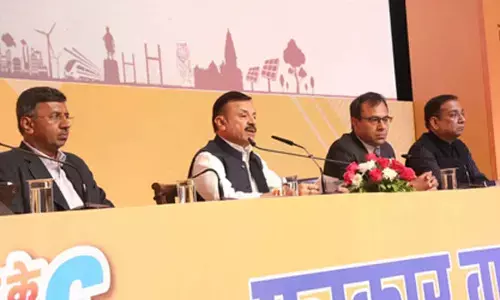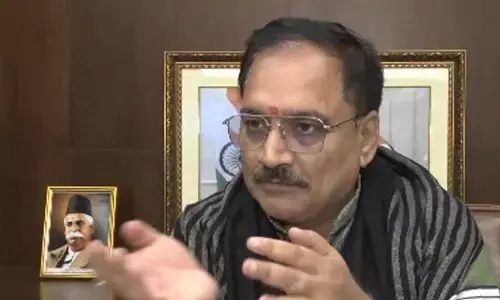An analysis on the role of India’s informal economy

The informal sector is commonly thought of as a site of low-skilled or unskilled work. The National Commission on Enterprises in the Unorganised Sector (NCEUS) took the position that the vast majority of the informal workforce is unskilled.
The informal sector is commonly thought of as a site of low-skilled or unskilled work. The National Commission on Enterprises in the Unorganised Sector (NCEUS) took the position that the vast majority of the informal workforce is unskilled.
This conclusion relies on two empirical facts: the low levels of formal education and training among informal sector workers and low wages as well as low productivity prevailing in this sector Our country’s socio-economic space is overwhelmingly informal whether it is relating to employment or other aspects of our life. However we tend to overlook and underestimate the importance of this sector which is multi-dimensional in its structure.
• According to ILO India Labour Market Update (2016) and NSSO data (2011-12), more than 90 percent of the employment in the agricultural sector and close to 70 percent in the non-agricultural sector falls under the informal category.
• Clearly, the informal sector is not the residual sector of the economy. In reality, it is the dominant sector.
• The informal sector may not contribute much to the national income but its dominance in employment is likely to continue for some more time.
• Even while the organised sector has lagged behind, the informal sector has shown improvement in productivity, real wages, employment and capital accumulation.
• It may be wrong to look down upon the informal sector as stagnant and under-performing.
• Empirical data underlines the fact that the informal sector has done better than its formal counterparts on economic parameters such as investment, job creation and accumulation of fixed assets, among others.
Present scenario
• At present, only 10% of India’s over 470 million workforces is in the formal sector. In other words, 90% of India’s workers do not have the privileges—like social security and workplace benefits—enjoyed by their counterparts who are formally employed.
• It is estimated by NSSO that 84.7% of jobs in the Indian economy are in the informal or unorganised sector. Of this, excluding agriculture, the leading contributors of informal employment are manufacturing, construction and trade.
• According to the Report of the Committee on Unorganized Sector Statistics, the informal economy makes a considerable contribution to the economy and caters to the requirements of the formal economy. However, its negative repercussions cannot be ignored.
• Studies show that employees tend to be significantly more productive in the formal employment when compared to the informal employment. Also, the quantum of value added by a person in a formal job is almost double that of a person in an informal job.
• Informal workers also work under worse working conditions with little job security, no perks or protections and with low wages. The protections guaranteed to workers under different legislations are not complied with by the informal sector, and they also escape the purview of the authorities.
• A large informal sector also impacts the government in terms of revenue foregone because the units operating in the informal sector stay out of the government’s fiscal revenue net (This leads to low tax GDP ratio). Hence, the informal sector is detrimental to the interests of the working population, the government and in the long run, even to the employer.
Structure of informal economy
• First, the informal economy (IE) is not transitory.
• The concept was developed (for conditions in West and East Africa) in the 1970s when it was expected that unregistered activity would be rapidly subsumed under the formal, nation-building processes of industrialization (including that of agriculture), urbanization and banking.
• With the passage of the ‘development decades’, it became clear that the IE was hard-wired into the structure of many economies in which formal registered activity not only directly exploited the IE through subcontracting but also gained from the cheap products and services it generated.
• Latterly, the ubiquity of informal (unregistered) wage labour has expanded the scope of the concept, even while it was being criticized.
• In research aimed at discovering why targeted beneficiaries are frequently victims rather than beneficiaries, the apparatus of policy making and implementation has itself been widely perceived to be informalised.
• Research into election funding has also shown how the IE and the black economy are the inescapable basis of India’s representative politics.
• Second, India’s IE is not marginal, a minor component of the economy as in the other BRICS and the EU, it is distinctively pervasive: an estimated 92.5 per cent of livelihoods are not registered, producing up to two thirds of the country’s GDP and showing no signs of retreat.
• The statistical estimation process through which these figures have been produced is being threatened by financial pressures on the focus and quality of data gathering, while the alternative method of estimation, by scaling-up the results of (more or less arbitrarily chosen) small scale surveys and case material, sets up epistemological discontinuities.
• These are two different ‘ways of knowing’, using categories and concepts that cannot always be reconciled with the national accounts.9 But there is no denying that not only is the IE enduringly pervasive, it also drives growth and is providing all the jobs compensating for the ‘jobless growth’ process.
• So despite post-independence planning, it is self-evidently at the core of India’s competitive advantage.
• Third, the IE is not just the abode of poverty, although all poverty and all of what the ILO calls ‘indecent’ work (i.e. work without effective rights at work, rights to organise or rights to receive social protection) is in the IE.
• For the most part, poverty has been addressed through welfare transfers to workers and their households as citizens rather than as workers.
• Wealth is also generated and stored in the IE.And it is in the IE that the broad economic relations that link wealth to poverty, and cause poverty, are most clearly visible.
• Fourth, the IE is ‘unorganised’. Although it is labelled as such in statistical and official documents, it does not follow that the IE is disorganized; and how it is actually organized has great salience for any future attempt to improve production conditions.
• Informal markets are not state-regulated, but socially regulated. Thousands of chambers of commerce, and tens of thousands of business associations, exercise a societal corporatist control over apprenticeships, entry to jobs and access to work sites; they informally certificate competences and skill;
they manage disputes over contracts, influence price-formation and dictate terms in derived markets (especially markets for labour); they organize collective insurance, represent and defend their patches from threats from the state, create rents and share them with state officials, mobilize redistributive resources for those they approve, disseminate innovative information about technology and demand, and much more.
• So-called ‘soft’ institutions of identity - such as gender, ethnicity, religion, place, language and caste (though caste is dissolving unevenly as a structure of occupation, many local sangams have historical roots in caste associations) have proved more compatible with the capitalist economy than theorists of development have been inclined to acknowledge.
• In fact, they are being reworked to become not soft but hard regulators of economic opportunity, entry and practice: they limit the mobility of both capital and labour but simultaneously facilitate, structure and stabilise economic growth.
• Fifth, the IE is not confined to small economic entities though these are overwhelmingly prevalent. An estimated 95 per cent of all firms employ fewer than 5 wage-workers, the average having fallen from about 2.9 in 1990 to 2.4 in 2005.
• Liberalization has generated a torrent of tiny firms. On grounds of small size, lack of eligibility for social protection and vulnerability, under the Labour Laws, the owners of such firms are defined as labour.
• Exploitive employers are thus made eligible for the same formal rights as their employees. Of the 95 per cent of these owners of firms, the vast majority are in wholesale and retail trade, self-employed ‘petty commodity producers’ (PCP). PCP is the commonest form of livelihood in India’s entire economy - formal and informal.
Reasons for informalisation
1. Restrictive labour laws – which promote contract hiring in order to circumvent rigid hiring and firing provisions?
2. Predominance of service-sector led growth – which requires skilled labour that was available with a miniscule section of the population.
3. Absence of thrust on manufacturing – which can lead to creation of formal employment for millions looking to move away from agriculture.
4. Market-mechanisms and competition led to closure of obsolete industries such as textile mills, reducing formal jobs. The newer industries were capital intensive rather than labour intensive, thus absorbing lesser workforce than what they laid to retrenchment of.
5. Lack of an exit mechanism such as insolvency and bankruptcy laws has led to firms remaining small, barely breaking even, and not scaling up. Such small firms can circumvent formal sector laws such as mandatory registrations with the EPFO etc. rendering them informal.
6. The advent of the Fourth Industrial Revolution and automation poses even more dangers to present formal sector jobs since workers with current skills will be rendered obsolete unless they undergo skill reorientation.
7. India, with increasing integration into global economy, also suffered during various global crises such as the Southeast Asian crisis, Gobal Financial Crisis in 2008 and the Eurozone crisis in 2011. This shelved corporate expansion plans and led to closure of several industries, reducing formal sector employment.
Increasing in formalisation is detrimental to economic development as:
1. Informal workers lack proper wages. Lower wages lead to increasing inequality, which is detrimental to development.
2. Low wages lead to a low savings rate, which is detrimental for the credit cycle and further lending, hampering development.
3. Informal workers lack welfare benefits such as healthcare, insurance, and education facilities. This leads to increased out of pocket expenditures on those things >> increases poverty and inequality >> detrimental to development.
4. Contract labour has no affinity or loyalty towards the company, thus hampering productivity and economic development.
5. Informal sector workers usually lack financial literacy, depriving them of access to institutional credit, thus reducing domestic consumption and harming development.
6. Productivity of the economy decreases as a whole since companies lose the incentive to skill the employees, so that they can better reorient themselves to the demands of the economy.
7. Lack of formal sector benefits such as maternity leaves etc leads to improper development of the child >> hampers human resource development.
8. Informal sector is predominantly cash-based. This is a major source of generation of black money and tax evasion. Size of Indian black economy is estimated at nearly 24% of GDP. This deprives the State of legitimate taxes, hampering development.
9. A low tax base due to low formal sector >> low tax revenue >> increased government borrowing (for counter-cyclical purposes) >> higher fiscal deficit >> higher inflation >> affects the low-wage informal workers the most, thus perpetuating a vicious cycle and hampering development.
10. High FD and high inflation also lead to credit downgrades and lead to outflow of foreign investments due to macroeconomic instability. This is catastrophic for a capital-starved country like India.
With India at the cusp of a demographic transition and adding a million workers to its workforce every month, there is a dire need to create formal sector jobs. Government initiatives like Make in India, Skill India, labour reforms, Insolvency code et all have to work in tandem to ensure that this workforce is formalized and the fruits of development accrue equitable to all workers within the country.
Big concern: Challenge of job creation
• It is generally agreed that a key element in the transformation of India is the creation of a large number of good jobs.
• However, by all estimates, the economy has seen a deceleration in the pace of employment creation with actual employment generation in the economy not even a fraction of the estimated 20 million jobs that need to be created every year as per government’s own commitment.
• Recent reports on massive job losses in the organized information technology (IT) sector of more than 50,000 this year have only contributed to the gloom.
• Industry analysts suggest the situation may worsen in the coming years. That leaves the informal sector as the only saviour in the employment creation crisis.
• But can the informal sector absorb the labour force which is entering the labour market every year? Whether it can deliver on the promise of employment creation without any state support?
• The challenge is not just to provide employment to the new entrants in the labour force, but also to the millions who leave the agricultural sector in search of employment in the non-farm sector.
• As the ILO and NSSO data pointed out – out of total net addition to jobs in the economy, the bulk of this was in the informal sector.
• These jobs, which were largely casual in nature, were created in sectors such as construction, retail trade and transportation. In most of these sectors, the majority of employment is informal.
• Nearly 50% of workers are employed as informal workers. The share of informal workers in the private organized sector is as high as two-thirds of all employment.
• Increasing recourse to contractual workers by the organized sector is a trend that has gained momentum in the last decade, swelling the ranks of informal workers.
• But the informal sector remains neglected in most policy initiatives. It was also the biggest sufferer in the demonetization drive last year but has bounced back since then.
• Despite its overwhelming contribution to the economy and employment, it is generally seen as parasitic with no contribution to tax income of the government and also because it is unregulated.
• Despite employing the majority of the workers in the economy, the informal sector continues to show low productivity. In most non-farm informal sectors, productivity levels are not very different from the agricultural sector, which remains the sector with the lowest productivity.
• With all its limitations, the informal sector continues to remain large and hasn’t shown signs of disappearing.
Should informal sector be regulated?
• It seems more logical to take the informal economy of India as the mainstream which requires a proper regulatory framework to ensure that those who drive this sector are provided the opportunity to contribute to the well being of the nation while enjoying a life of dignity and an environment of ‘decent work’.
• Most government policies attempt to regulate the informal sector and bring it into the mainstream, with the overall objective of reducing its share in the economy. However, any attempt to regulate it to bring it into the tax net, without adequate support, may kill the sector which has so far managed to absorb labour which is unskilled and uneducated.
• Majority of the workers moving out of agriculture are unskilled and have low levels of education. These workers are unlikely to be absorbed in the formal sector.
• Secondly, even though the informal sector is unregulated, it is not competing with the formal sector and is therefore unlikely to affect it. The cost of adhering to regulation and taxes will not only add to the cost of production but will also render the informal sector unviable.
• Therefore, the best way is to recognize that the informal sector is the new normal. Despite its problems, it will continue to remain important for the economy.
• It may not contribute much to the national income but its dominance in employment is likely to continue for some more time. This is not only true for the informal manufacturing sector but also for the services sector which is likely to be the driver for employment creation.
• It is not just cab hailing services like Uber that are creating a large workforce of self-employed workers including in small and medium towns.
• A large majority of workers in these sectors are not in employer-employee relationships but are either self-employed or casual/contractual employees.
Need of the hour:
• What is needed is to upgrade the skills of those who are already in the informal sector with government support through easier access to credit, technology and availability of markets.
• Unfortunately, existing labour laws have failed to help informal sector workers. What is needed is social security architecture to be provided by the government for informal sector workers.
• Such a proposal was part of the recommendations of the National Commission for Enterprises in the Unorganized Sector (NCEUS). However, there has not been any progress in implementing these.
• What the informal sector needs is less of regulation and more of support as against the government policy of more regulation and no support.
• Any attempt to regulate and bring the informal sector into the tax network will only add to costs without increasing productivity. The formal and informal sectors are complementary to each other and any attempt to use one against the other will harm both.
• It is time to use the opportunity that the informal sector provides to strengthen and support it. This is not only essential for economic growth but the only way for growth with jobs.
Impact of demonetisation on informal economy
• The growth estimates put out by the Central Statistical Organisation (CSO) in the Second Advance Estimates of National Income for the year and the third quarter estimates have raised many eyebrows. As against the Bloomberg consensus estimate of 6.1% for the quarter, the CSO’s estimate shows the growth of 7%.
• The second advance estimate of GDP for FY17 is 7.1%, which takes account of the effect of the note-ban, and is exactly identical to the first estimate.
• In fact, both the Reserve Bank of India as well as the Economic Survey put out by the Union ministry of finance have admitted to the fact that the note-ban would have adverse impact on growth and the latter speculates the reduction in the growth by 0.25-0.5%.
• The growth estimate remaining unchanged at 7.1% in the second advance estimate has led some to erroneously conclude that demonetisation has not had any significant impact on the growth rate while others have raised suspicions on the estimate itself.
• The fact is that there has been an effect and this is revealed by the analysis of growth composition of different sectors. Besides, as stated by the chief statistician, TCA Anant, the impact of the note-ban is yet to play out completely.
• Thus, there is no need either to be jubilant about the note-ban nor is there any case for stating, “lies, damn lies and statistics!”
• From the policy perspective, it is important to note that the growth rate of GDP in the current year has decelerated significantly over the previous year from 7.9% to 7.1%.
• The deceleration in the gross value added (GVA), which is the real measure of economic activity, has been much sharper, from 7.8% to 6.7%.
• Except for agriculture and public administration, the growth rate was either stagnant or declined by various magnitudes in other sectors.
• In agriculture, thanks to the bountiful monsoon, the growth is estimated to have accelerated from 0.8% in FY16 to 4.4% in the current year, and in public administration, thanks to the pay revision, the growth rate increased from 6.9% to 11.2%. The sharpest decline in the growth was in mining (from 12.3% to 1.3%), financial and real estate sector (from 10.8% to 6.5%) and manufacturing (from 10.6% to 7.7%).
Expected Questions:
• Job creation is taking place in the informal sector, there is a need to get them into the formal fold. Do you agree with this view? Give arguments in favour of your answer.
• There is a debate in the country whether to regulate the informal sector or not. What in your opinion is the best solution? Discuss.
Syllabus
General Studies 3
• Indian Economy and issues relating to planning, mobilization of resources, growth, development and employment.
• Inclusive growth and issues arising from it.
By Gudipati Rajendera Kumar

















